Capitalizing on the panicked sell-off in junior oil and gas stocks may prove to be a smart move now, as oil prices have recovered some 50% since crashing to $42/barrel WTIC in March, whereas many juniors still trade at relatively low levels.
While some experts are still bearish awaiting their earlier forecast of a final drop below $40, others expect oil to recover to $75 in the near-term as this level represents global marginal cost of production. Investment banker Angelo Damaskos, Principal Adviser of the Junior Oils Trust, admonished recently:
“The longer oil trades below that price level, we lose supply not only from the North American shale industry, but also from the longer-term producing projects: the Canadian tar sands and the Brazilian offshore basins. The oil price has recovered by 20-25% from January's lows but remains 50% lower than last year's highs. As a result, there has been a dramatic drop in income and earnings, which has been met with big cutbacks in capital expenditure (capex) and development drilling. The length of time oil trades below $75/bbl is a clue to how strong the recovery might be once a supply-demand balance is again achieved."
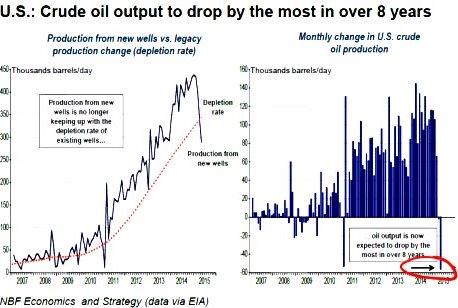
On the other side, dark clouds are put into perspective. In its latest strategy report, OPEC forecasts an oil price at $76 in 2025 in its most optimistic scenario and does not expect oil prices to consistently trade at $100 again in the next decade. “The days of oil fetching $100 a barrel are over for the foreseeable future,“ Qatar’s veteran former Energy Minister Abdullah Al Attiyahsaid said, predicting that prices will settle at between $60-70.
Last Friday (May 15), Reuters reported Venezuela eying at $100 oil price and dealing with OPEC to boost prices as “it’s in the best interest of Venezuela and OPEC for the price of oil to stabilize at 100 dollars in the medium term,“ said Nicolas Maduro, President of Venezuela. "We're currently working on a deal that hopefully can materialize in June regarding an announcement between OPEC and some of the most important oil producers in the world to finish stabilizing the market in the second half of the year," Maduro said after a meeting with Qatar's emir.
The International Energy Agency (IEA), and others, indicate oil demand will remain steady and project a slight growth in 2015. Assuming global economic growth has stabilized, demand for oil should remain firm, whereas current low prices may further stimulate demand and buying activity.
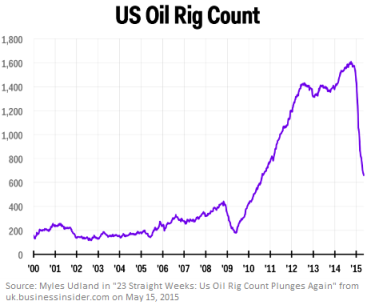
In consideration of the massive drop of active oil and gas rigs in the US, drilling costs have nosedived accordingly. This represents best time to bring online new production wells, if one speculates demand to remain robust.
· Latest data from Baker Hughes (NYSE:BHI) showed on Friday that the number of US rigs actively drilling for oil fell for its 23rd week in a row, down by 8 rigs for the week to 660.
· Gas rigs were up by 2 totaling 223 this week.
· For all US rigs actively drilling for oil and natural gas, the number fell by 6 rigs to 888; the count is down 973 rigs from last year, Myra Saefing from Marketwatch computed.
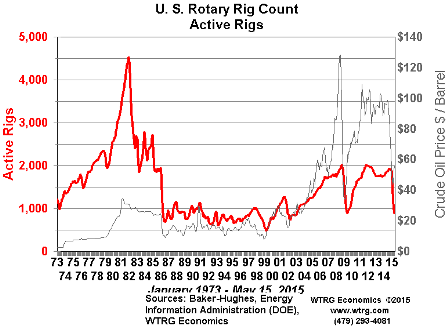
· When oil prices crashed in 2008/2009 by 77% from $145 to $34, the number of active US rigs collapsed by 50% from around 2,000 to 1,000 rigs.
· When oil prices crashed in 2014/2015 by 61% from $107 to $42, the number of active US rigs collapsed also by 50%, from same levels.
This indicates that some producers may think that the current oil correction is not over yet and should fall to $25 to provide a similar 77% correction like 2008/2009. However, if it turns out that oil prices have ended the correction already, producers are caught on the wrong foot and are likely to come back more aggressive as it was the case in 2009/2010, when doubling their rigs in snatches. Keith Schaefer from oilandgas-investments.com recently chatted on chat.ceo.ca:
“It’s intriguing to me how all the surprises in the energy market in 2015 have been bullish. Global demand around the world for oil is higher than anyone expected at these lower prices. Another one is the drill rig count in the US – nobody thought the producers would have that much discipline to drop that many rigs that fast.“
The rig count – a proxy for activity in the industry – is down 58% since a peak of 1,609 rigs in October. Paul Ausick said on May 9:
“In less than 5 months, the country lost more than half of all its oil rigs. While the number is remarkable, even more remarkable is the speed with which the spigot has been turned off. We may be about to find out how quickly that spigot can be turned back on.“
Looking at the impressive rebound of oil prices since March, he interprets this as “the strongest signal yet to producers that demand is returning, and as demand returns so will production.“ Phil Flynn from Price Futures Group said on May 15:
“As the rig-count cut slaughter continues…we will see it impact output more and more over the coming weeks and months.”
The tide is already turning in the futures market, according to Paul Ausick:
“Hedge funds — under the Managed Money heading in the Commodity Futures Trading Commission (CFTC) Commitments of Traders report — increased their long positions by about 1,500 contracts last week and reduced their short positions by about 7,500 contracts. The decreases reflect changes due to the May 5 settlement date. Managed Money holds 340,604 long positions, compared with 74,294 short positions. Among the producers themselves, short positions outnumber longs, 398,478 to 233,630. But the number of new long positions last week was double the number of new shorts. Positions among swaps dealers show 360,469 shorts versus 196,807 longs. Swaps dealers increased their short positions by a total of nearly 17,000 contracts last week.“
This appears to be an opportune time to build positions in oil and gas developers and producers, whereas ample focus can be put on companies active in the US and reporting in Canadian dollar. Geoffrey Smith from Fortune recalled last month:
“When a commodity price collapses, it’s only natural to see a shakeout among the companies that produce it. The weak go the wall and the strong salvage from the wreckage what they think will make them stronger.“
Such statements serve well to look for oil and gas developers, as well as producers, in the red and on the way becoming profitable again with higher prices, and/or ready to be swallowed by seniors for peanuts at such low price levels as today.
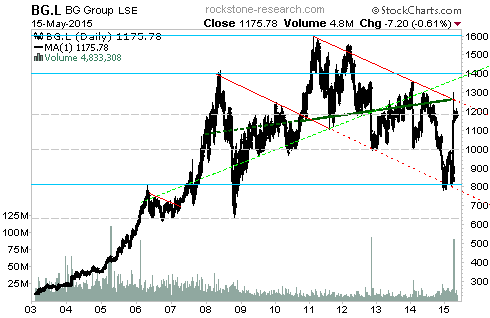
Link to above chart (15 min. delayed): http://schrts.co/sU3bYG
“The proposed takeover of BG Group (LONDON:BG) Plc by Royal Dutch Shell (LONDON:RDSa) illustrates the opportunity available to cash-rich companies. Shell, like other supermajor, integrated companies, has been suffering from declining reserve life and insufficient production replacement for years. Its 2014 reserves replacement ratio was 49%, of which only 17% came from exploration. Meanwhile, its 2014 reserves life index declined to 11 years from 12.3 years in 2013. In the present environment, it is cheaper to buy proven reserves than pursue expensive and risky exploration. British Gas carries substantial debt and had to take huge write-downs as a result of the price drop because many of its assets have been impaired. Nevertheless, BG offers Shell very large proven reserves and production in a global portfolio, as well as attractive development projects in emerging regions such as Australia and Brazil. Shell got BG at a very attractive price, and this deal sorts out its declining reserves problem. Shell also gains a much-larger global presence and will likely realize savings deriving from the elimination of duplicated functions. Shell expects the oil price to recover to $90/bbl by 2018. So the industry is fairly bullish on long-term oil prices, and we expect the pace of M&A to accelerate.“
-Angelo Damaskos, CEO of London-based Sector Investment Managers Ltd., a regulated investment advisory company, in a recent interview; Damaskos worked a decade for the European Bank for Reconstruction & Development
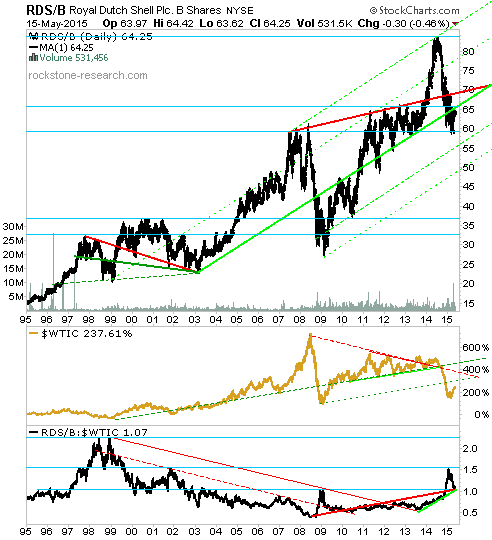
Link to above chart (15 min. delayed): http://schrts.co/2r2CJ2
On May 17, the German magazine Börse am Sonntag wrote an article on Shell and its recently granted permission to drill for oil and gas in the north-western sea of Alaska, along with the recent take-over of British Gas (BG Group):
“Despite the drilling permission, the stock market is not really euphoric yet. The stock rose slightly from 28 to 29.50 euro. However, the stock declined during the week. Maybe the skepticism is still big because the company, like the rest of the industry, is still struggling with the oil price decline since last year, in which time the price halved. The first quarter of this year saw a substantial drop in Shell’s profits. The operating profit decreased more than half to 3.2 billion USD. However, this is still 2.5 billion USD more than analysts calculated and expected. The energy giant still has ambitious plans. In this year alone, the company has sold assets worth more than 2 billion USD. In April, the take-over of BG Group for 47 billion GBP was announced. By that, a stronger company shall evolve.“
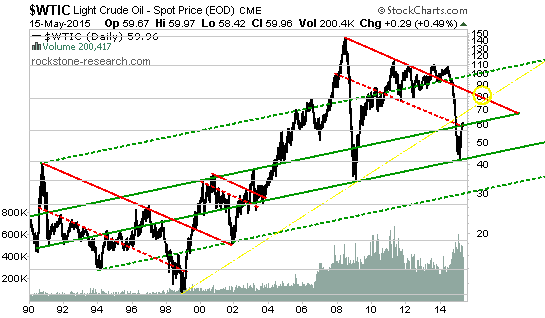
Link to above chart (15 min. delayed): http://schrts.co/5xghzH
Technically, the WTIC oil price fluctuates within the long-term (green) upward trend channels. As the price recently succeeded in rebounding above the (green) trendline at around $60, as well as the (red-dotted) resistance, a strong buy-signal is active (sell-signal when breaching both these new supports). Next larger resistance sits at the (red) trendline at around $80; thus a rally in the magnitude of +33% from current price is anticipated in the upcoming weeks.
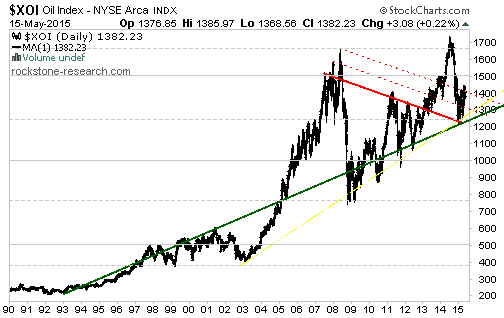
Link to above chart (15 min. delayed): http://schrts.co/aK1Pc3
The XOI oil company index dropped 30% since its all-time high above 1,700 points. Technically, this correction is merely a so-called pullback to the apex of the (red-green) triangle which has built up a massive sideways consolidation since 2005. In 2013, the price managed to rise above the resistive (red) triangle leg at around 1,300 points, whereas a so-called breakout started. It is typical for triangular price formations to conduct a pullback after the initial breakout – in order to test and potentially confirm former (red) resistance as new support; which can be classified as a healthy move for a sustainable upward trend to start thereafter. After the classical breakout and pullback moves, a triangle typically finishes off with a so-called thrust (either a strong up- or downward move). Since the price has started to move up after reaching the triangle’s apex, a thrust to the upside is anticipated. The goal of a thrust to the upside is to transform the resistive high of the triangle (1,500 points) as well as the high of the breakout (1,700 points) into new support – in order for a new and sustainable upward trend to start thereafter. Hence, a +23% move of the XOI is expected in the short-term. A major sell-signal is generated only when the price drops below the (green) support currently at around 1,200 points (as a thrust to the downside threatens).

Link to above chart (15 min. delayed): http://schrts.co/nezdjf
The XNG natural gas company index has been moving hand in hand with the XOI index. In 2013, the price succeeded in rising above the (red) triangle leg at 700 points, whereafter a +38% breakout to 965 points occurred. The subsequent pullback to the apex of the (red-green) triangle at 700 points marks the end of the triangle. Since the price has started move up lately, a thrust to the upside is anticipated with the goal of transforming the all-time high at 965 points into support in order for a sustainable upward trend to start thereafter.
